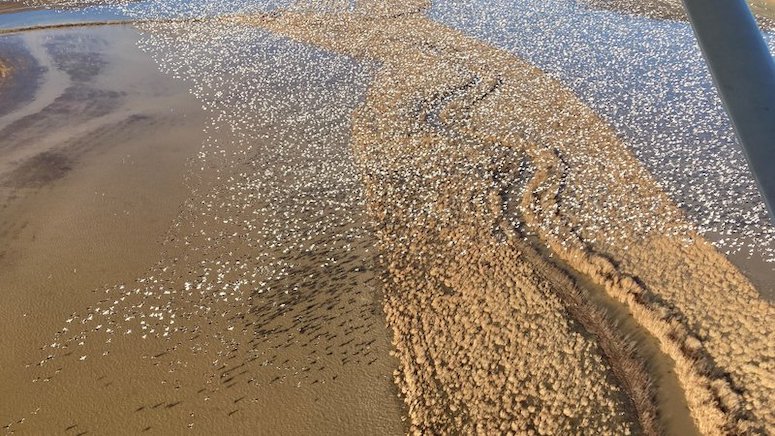LITTLE ROCK – The best mallard numbers seen in Arkansas in recent years from last month’s aerial survey estimate continued with the Arkansas Game and Fish Commission’s annual midwinter waterfowl survey released this week. The number of mallards in the Delta region of Arkansas hit a four-year high during aerial observations conducted in December, and that was repeated with last week’s count.
Observers estimated 929,248 mallards and more than 1.74 million total ducks on transect lines in eastern Arkansas. Not only was this the highest mallard population recorded during the midwinter survey since 2018, it was the second-highest since 2010. Total duck population estimates also exceeded 1.5 million for the first time in any survey since December 2011.
The aerial survey took place after the influx of arctic air in late December, snow and ice cover in states above Arkansas, and in conjunction with the massive amounts of rainfall in Arkansas during the survey period last week.

The highest mallard and total duck estimates were in the Lower St. Francis survey zone, a region known for more boom-or-bust duck counts driven by the extent of natural flooding on the landscape. Hotspot maps indicated several duck concentration areas throughout the Delta.
Arctic goose population estimates totaled 1,693,343 light geese (lesser snow geese and Ross’s) and 618,925 greater white-fronted geese in the Delta as well.
“The timing of the surveys fell right in line with flooding from the massive storm front that came through Arkansas, and hunters know that ducks have an innate ability to find newly flooded areas and make use of the new habitat and food,” Luke Naylor, AGFC chief of wildlife management, said. “Information from locations north of Arkansas suggested ducks had headed south prior to this event and no doubt found abundant new habitat to settle into across the state.”
Other portions of the state saw variable numbers of ducks, with the Arkansas River Valley recording populations near the long-term average for the midwinter survey and southwestern Arkansas having lower than normal duck populations. The Delta’s rich habitat seemed to be the focus of the waterfowl. Biologists flying along survey routes in the Arkansas River Valley recorded 41,017 total ducks, including 25,943 mallards. Biologists performing cruise surveys in southwest Arkansas reported an estimated 14,283 ducks with 6,180 mallards.
Naylor says improved duck production across the Prairie Pothole Region in 2022 may have contributed to higher midcontinent mallard fall flights and some of the Delta estimate increases, but post-season analysis of duck wings submitted by hunters will be needed to provide insight on the amount of hatch-year birds in the 2022 fall flight.
According to Naylor, the flights for these surveys are conducted at very low elevations, where dangerous situations can arise due to birds flying into the path of the plane if they become spooked. At least one bird strike was recorded during the flights in early January but luckily no one was injured. Biologists Jason Carbaugh, Jason Jackson, Cameron Tatom and Alex Zachary conducted the low-level surveys with contracted pilots. Naylor said, “They have faced some tough conditions this year with delayed surveys from weather conditions and dodging birds, but have done an excellent job of keeping the data as consistent as possible to make accurate evaluations of duck populations so far this season.”
Continue Vigilance With Avian Flu
Hunters are urged by the AGFC to maintain a vigilant lookout for any birds that might be infected or suffering from Highly Pathogenic Avian Influenza. HPAI has been a concern of wildlife biologists this late fall and winter, especially with much evidence of it seen recently among migrating snow geese and other waterfowl and wintering birds in Arkansas. Hunters, outdoors enthusiasts and wildlife watchers are asked to report instances of dead or sick waterfowl that they encounter in the wild. The risk of humans contracting the disease remains low, but hunters can help further minimize that risk by following a few simple precautions (see below). Anyone who observes concentrations of sick or dead birds should report their sighting by using the AGFC’s Avian Influenza Reporting Form.
More information on avian influenza information is available at AGFC, Ducks Unlimited, and USDA APHIS’s website.
Bag Limits
Remember: Daily bag limits are the same as seen in recent years. Hunters make harvest a bag limit of 6 ducks, which may include no more than 4 mallards (2 hens), 1 scaup, 3 wood ducks, 1 pintail, 2 redheads, 2 canvasbacks, 2 black ducks or 1 mottled duck. Beyond those exceptions, the limit is up to 6 ducks of a species, including teal. The merganser daily bag limit is 5, with only 2 hooded mergansers allowed. The daily bag limit for coots is 15. Non-lead shot must be used for waterfowl hunting in Arkansas. The possession limit for ducks, coots and mergansers is three times the daily bag limit. The daily bag limit for greater white-fronted geese 3, up from last year’s 2 birds per day. The daily limit for snow, blue and Ross’s geese is 20 per day.
Waterfowl season in Arkansas will closes at sunset Jan. 31.


